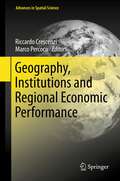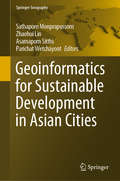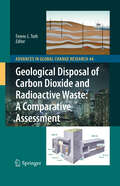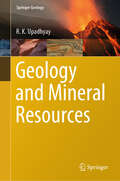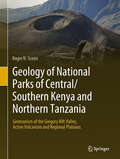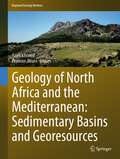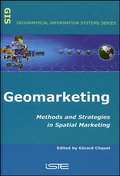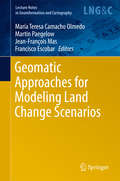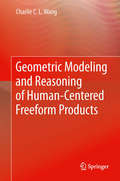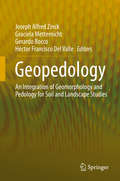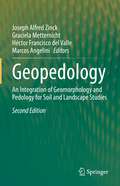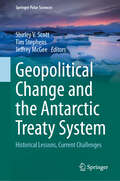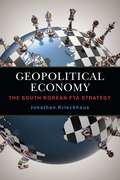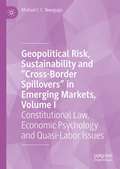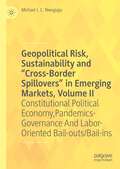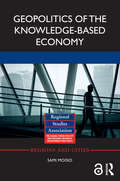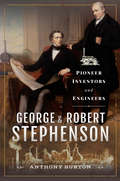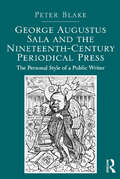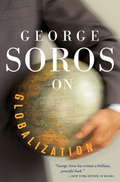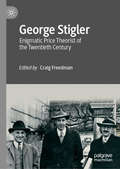- Table View
- List View
Geography, Institutions and Regional Economic Performance
by Marco Percoco Riccardo CrescenziThe book aims to present "traditional features" of regional science (as geographical concepts and institutions), as well as relatively new topics such as innovation and agglomeration economies. In particular it demonstrates that, contrary to what has been argued by recent economics literature, both geography and institutions (or culture) are relevant for local development. In fact, these phenomena, along with the movement of goods and workers, are among the main reasons for persisting development differentials. These intriguing relationships are at the heart of the analysis presented in this book and form the conceptual basis for a promising institutional approach to economic geography.
Geoinformatics for Sustainable Development in Asian Cities (Springer Geography)
by Sathaporn Monprapussorn Zhaohui Lin Asamaporn Sitthi Parichat WetchayontThis proceedings volume focuses on the importance and power of spatial thinking and planning, especially by applying geospatial technologies in solving the past and current global problems such as environmental degradation, urban pollution, climate change, agricultural management and epidemiology.The proceedings of the International Conference on Geography and Geoinformatics for Sustainable Development 2018 (ICGGS 2018) consist of a wide range of case studies from developing countries. The contributions address challenges of developing countries in mainstreaming sustainable development paradigm into their economy with the aim to improve and manage natural resources and environment in a sustainable manner. One of the main goals of the conference and the proceedings is to share and exchange different perspectives on global, regional and local spatial issues and how the concept of spatial planning and thinking can be used in building resilience to natural and anthropogenic threats in many sectors (such as water, ecosystem, agriculture and health). This includes a summary of how the key concepts of geospatial technologies could contribute to environmental sustainability and the Sustainable Development Goals (SDGs) as well as an outlook on challenges and opportunities for sustainable development. This book explains how geoinformatics can help analyse, model and explain sustainable development within a geographic context and thus provide the integrative framework necessary for global collaboration consensus and evidence-based decision-making. It highlights the vital and integrative role of geospatial information in driving sustainable development and thus can be used as a tool to put the 2030 Agenda for Sustainable Development into practice. This volume can be a useful resource for readers regarding research on geospatial issues on both the regional and local scale. Both undergraduate and graduate students around the globe can advance their academic and research knowledge of past and present environmental problems and learn how geospatial planning can be applied for sustainable development. It also appeals to researchers, academics, practitioners, community developers and policy makers interested in promoting sustainable development.
Geological Disposal of Carbon Dioxide and Radioactive Waste: A Comparative Assessment
by Ferenc L. TothFossil fuels will remain the backbone of the global energy economy for the foreseeable future. The contribution of nuclear energy to the global energy supply is also expected to increase. With the pressing need to mitigate climate change and reduce greenhouse gas emissions, the fossil energy industry is exploring the possibility of carbon dioxide disposal in geological media. Geological disposal has been studied for decades by the nuclear industry with a view to ensuring the safe containment of its wastes. Geological disposal of carbon dioxide and that of radioactive waste gives rise to many common concerns in domains ranging from geology to public acceptance. In this respect, comparative assessments reveal many similarities, ranging from the transformation of the geological environment and safety and monitoring concerns to regulatory, liability and public acceptance issues. However, there are profound differences on a broad range of issues as well, such as the quantities and hazardous features of the materials to be disposed of, the characteristics of the targeted geological media, the site engineering technologies involved and the timescales required for safe containment at the disposal location. There are ample opportunities to learn from comparisons and to derive insights that will assist policymakers responsible for national energy strategies and international climate policies.
Geology and Mineral Resources (Springer Geology)
by R. K. UpadhyayThis book focuses on understanding Earth’s geology, its mineral resources, their exploration, and management of the environment. There are 3 parts and 12 chapters, and they provide an insight to the students of earth sciences. Part I, consisting of initial four chapters, provides snapshots on the Universe, the Earth, and its internal dynamics, and external geological processes. The mineral resources are covered in Part II with 5 chapters, featuring Earth’s elements, metals, minerals, rocks, and the mineral resources. As they are non-renewable, the importance of their scientific exploration, evaluation, mining, beneficiation, optimum utilization, and adverse impact, safety management, and environment are covered in the last 3 chapters in Part III.
Geology of National Parks of Central/Southern Kenya and Northern Tanzania: Geotourism Of The Gregory Rift Valley, Active Volcanism And Regional Plateaus
by Roger N. ScoonThis book describes the interrelationship between the spectacular geology of an area of East Africa that includes a branch of the rift valley, as well as giant freestanding ice-capped mountains and extraordinarily toxic, alkaline lakes, and some of the greatest concentrations of wildlife on Earth. It suggests that geological processes that have shaped the iconic landforms, including active volcanoes, may also be responsible for the unusually diverse speciation which characterises the region. Moreover, it is not a coincidence that important palaeoanthropological discoveries have been unearthed in the region. National parks and conservation areas have tremendous potential for geotourism and the book assists both tour guides and visitors in this regard. In addition, the book may provide a better understanding to management of the importance of geology for sustaining wildlife.
Geology of North Africa and the Mediterranean: Sedimentary Basins and Georesources (Regional Geology Reviews)
by Francois Roure Sami KhomsiThis book summarizes the links between the evolution of sedimentary basins of Northern Africa and Peri-Mediterranean in different tectonic settings and the distribution of georesources in those basins. Georesources include fossil energy, geothermal energy, deep aquifers, minerals and deposits. This book also provides key information for energy resources in these important areas. The book is in part a compilation of selected papers from Atlas Georesources International Congress, Hammamet, Tunisia, (AGIC 2017) which were extended after the congress in addition to other contributions from geoscientists based at some universities and companies from the region. It is organized in a set of research studies focusing on the architecture, geodynamic evolution and modeling of sedimentary basins in the Middle East, North Africa and the Mediterranean domain. Future developments in the exploration for water, energy and other georesources are very important in these regions. In this context, this book constitutes an important reference for a wide range of geoscientists and companies as it defines the distribution and potentialities of these resources.
Geomarketing: Methods and Strategies in Spatial Marketing
by Gérard CliquetThis title describes the state of the art in all areas of spatial marketing, discussing the various constituents which make up the geography of markets. Demand varies according to location and can be measured according to revenue, the number of households, spending patterns and lifestyles. Supply is also dependent on position, because prices, services, products and available shops rely on location, while the difference between supply and demand is the rationale for the role of the trader. The book also covers the way geographic techniques help to solve marketing problems and contains chapters written by contributors with extensive experience in this field; given that it is crucial for companies to direct their marketing correctly at their target audience, this will be indispensable reading for those involved in this area.
Geomatic Approaches for Modeling Land Change Scenarios
by Francisco Escobar María Teresa Camacho Olmedo Martin Paegelow Jean-François MasThis book provides a detailed overview of the concepts, techniques, applications, and methodological approaches involved in land use and cover change (LUCC) modeling, also known simply as land change modeling. More than 40 international experts in this field have participated in this book, which illustrates recent advances in LUCC modeling with examples from North and South America, the Middle East, and Europe. Given the broad range of geomatic approaches available, it helps readers select the approach that best meets their needs. The book is structured into five parts preceded by a foreword written by Roger White and a general introduction. Part I consists of four chapters, each of which focuses on a specific stage in the modeling process: calibration, simulation, validation, and scenarios. It presents and explains the fundamental ideas and concepts underlying LUCC modeling. This is complemented by a comparative analysis of the selected software packages, practically applied in various case studies in Part II and Part III. Part II discusses recently proposed methodological developments that have enhanced modeling procedures and results while Part III offers case studies as well as interesting, innovative methodological proposals. Part IV revises different fundamental techniques used in LUCC modeling and finally Part V describes the best-known software packages used in the applications presented in Parts II and III.
Geometric Modeling and Reasoning of Human-Centered Freeform Products
by Charlie C. WangThe recent trend in user-customized product design requires the shape of products to be automatically adjusted according to the human body's shape, so that people will feel more comfortable when wearing these products. Geometric approaches can be used to design the freeform shape of products worn by people, which can greatly improve the efficiency of design processes in various industries involving customized products (e.g., garment design, toy design, jewel design, shoe design, and design of medical devices, etc.). These products are usually composed of very complex geometric shapes (represented by free-form surfaces), and are not driven by a parameter table but a digital human model with free-form shapes or part of human bodies (e.g., wrist, foot, and head models). Geometric Modeling and Reasoning of Human-Centered Freeform Products introduces the algorithms of human body reconstruction, freeform product modeling, constraining and reconstructing freeform products, and shape optimization for improving the manufacturability of freeform products. Based on these techniques, the design automation problem for human-centered freeform products can be fundamentally solved. Researchers and developers working on problems of automatic designing individually customized products can use this book as a reference, and it can also be used in courses in computer-aided product design at the graduate level.
Geopedology
by Joseph Alfred Zinck Graciela Metternicht Gerardo Bocco Héctor Francisco Del ValleThis book offers a proven approach for reliable mapping of soil-landscape relationships to derive information for policy, planning and management at scales ranging from local to regional. It presents the theoretical and conceptual framework of the geopedologic approach and a bulk of applied research showing its application and benefits for knowledge generation relevant to geohazard studies, land use conflict analysis, land use planning, land degradation assessment, and land suitability analysis. Soil is a vital resource for society at large and an important determinant of the economic status of nations. The intensification of natural disasters and the increased land use competition for food and energy have raised awareness of the relevant role the pedosphere plays in natural and anthropogenic environments. Recent papers and global initiatives show a renewed interest in soil research and its applications for improved planning and management of this fragile and finite resource.
Geopedology: An Integration Of Geomorphology And Pedology For Soil And Landscape Studies
by Joseph Alfred Zinck Graciela Metternicht Héctor Francisco del Valle Marcos Angelini<p>This updated and revised second edition brings geopedology issues into the current context. This new edition extends the work on popular topics such as digital soil mapping, GIS and landscape mapping, and it also gives valuable insight with up-to-date theoretical discussions and new application with relevant case studies. This textbook offers a proven approach for reliable mapping of soil-landscape relationships to derive information for policy, planning and management at scales ranging from local to regional. Filled with didactic elements such as case studies, visual aids (maps, charts and figures), questions and answers, the book is of interest to geohazard studies, land use conflict analysis, land use planning, land degradation assessment, and land suitability analysis.<p> <p>Soil is a vital resource for society at large and an important determinant of the economic status of nations. The intensification of natural disasters and the increased land use competition for food and energy have raised awareness of the relevant role the pedosphere plays in natural and anthropogenic environments. Recent papers and global initiatives show a renewed interest in soil research and its applications for improved planning and management of this fragile and finite resource.<p>
Geopolitical Alpha: An Investment Framework for Predicting the Future
by Marko PapicForecast geopolitics and markets with this clear and insightful resource Geopolitical Alpha – An Investment Framework for Predicting the Future provides readers with an original and compelling approach to forecasting the future and beating the markets while doing so. Persuasively written by author, investment strategist, and geopolitical analyst Marko Papic, the book applies a novel framework for making sense of the cacophony of geopolitical risks with the eye towards generating investment-relevant insights. Geopolitical Alpha posits that investors should ignore the media-hyped narratives, insights from "smoke-filled rooms," and most of their political consultants and, instead, focus exclusively on the measurable, material constraints facing policymakers. In the tug-of-war between policymaker preferences and their constraints, the latter always win out in the end. Papic uses a wealth of examples from the past decade to illustrate how one can use his constraint-framework to generate Geopolitical Alpha. In the process, the book discusses: What paradigm shifts will drive investment returns over the next decade Why investment and corporate professionals can no longer treat geopolitics as an exogenous risk How to ignore the media and focus on what drives market narratives that generate returns Perfect for investors, C-suite executives, and investment professionals, Geopolitical Alpha belongs on the shelf of anyone interested in the intersection of geopolitics, economics, and finance.
Geopolitical Change and the Antarctic Treaty System: Historical Lessons, Current Challenges (Springer Polar Sciences)
by Shirley V. Scott Tim Stephens Jeffrey McGeeThis book explores how geopolitical tensions have shaped the Antarctic Treaty System (ATS) and offers insights into managing future challenges. The ATS, established with the 1959 Antarctic Treaty during the Cold War, has been a successful model of international governance, ensuring Antarctica's peaceful use and environmental protection. However, the ATS now faces new pressures, including an expanded membership of 57 states, increased economic activities such as tourism, fishing, and bio-prospecting, and the impacts of climate change. These factors are exacerbating geopolitical tensions that could challenge the stability of the ATS. The book examines key moments in the history of the ATS to understand how past tensions were managed and what lessons can be drawn for the future. The volume covers the creation of the CCAMLR marine conservation treaty in the late 1970s-1980s; the developing world's opposition to the ATS in United Nations debates during the 1980s-1990s; the shift from permitting Antarctic mining to establishing the Madrid Protocol on Environmental Protection in the early 1990s; the formation of the International Association of Antarctic Tourism Operators; the management of Illegal, Unregulated, and Unreported (IUU) fishing in the 2000s; and the proposals for marine protected areas under the CCAMLR Convention in recent years. Several contributions also draw on critical and regional perspectives to make sense of geopolitical pressures on Antarctic governance and how they might play out over the years and decades ahead. Through its attention both to critical turning points in the history of the ATS, and a broad range of conceptual approaches, the book provides an authoritative assessment of the ATS's capacity to address emerging geopolitical stresses and provides strategies for future governance. It is a timely resource for understanding the evolving dynamics in Antarctica and ensuring the region remains a zone of peace and scientific collaboration. This book is a companion volume to McGee, Edmiston and Haward, 2022, The Future of Antarctica: Scenarios form Classical Geopolitics, in the Springer Polar Sciences Series.
Geopolitical Economy: The South Korean FTA Strategy
by Jonathan KrieckhausGeopolitical Economy examines the significance and nature of free trade agreements (FTAs), the primary policy tool through which modern nations seek access to international markets and promote economic growth. The book focuses specifically on how South Korea, the world’s leader in the number and significance of FTAs as well as the world’s sixth largest export economy, uses FTAs. Jonathan Krieckhaus argues that geopolitics—the struggle between powerful nations over specific geographic regions around the globe—influenced FTA strategy and economic policy in South Korea and beyond. This perspective illustrates the security approach to FTAs, but adds that the geographic specificity of security concerns deeply shape FTA policy. Geopolitical Economy also looks at Korean FTAs through the lens of development strategy. South Korea is singularly successful in garnering FTAs with all three players in the global economy: the United States, the European Union, and China. This unprecedented success was built on a strong commitment from three consecutive Korean presidential administrations, each operating within a favorable state-society context that enjoyed the existence of a centralized and effective trade bureaucracy.
Geopolitical Risk, Sustainability and “Cross-Border Spillovers” in Emerging Markets, Volume I: Constitutional Law, Economic Psychology and Quasi-Labor Issues
by Michael I. NwoguguEconomic recessions, social networks, environmental damage in several large countries (eg. China, Brazil, U.S.), the Global Financial Crisis of 2007-2015 and cross-border spillovers continue to significantly affect economic systems, financial markets, social structures and environmental compliance worldwide. These have rekindled economists’ and policy-makers’ interest in the relationships among constitutions, risk regulation, foreign aid, political systems, government size, credit expansion and sustainable growth. Risk regulation remains highly ineffective as manifested by the failures of new financial regulations and government stimulus programs that were implemented during 2007-2020 in many developed countries and emerging markets countries.This book, the first of two volumes, addresses these issues in the context of the role of constitutional economics and economic psychology as tools for national and global sustainable growth and risk management. Furthermore, this volume analyzes the often symbiotic relationship between alternative sets of legal-institutional-constitutional rules that constrain the choices and activities of economic and political agents on one hand, and sustainable growth, financial regulation and the risk management of financial institutions on the other; and reviews the effects of constitutions and legal institutions on market dynamics (real estate; fixed-income, stocks; etc.) including volatility, market depth and liquidity. This book will help researchers develop better artificial intelligence and decision-systems models of geopolitical risk, public policy and international capital flows, all of which are increasingly relevant to investment managers, boards-of-directors and government officials.
Geopolitical Risk, Sustainability and “Cross-Border Spillovers” in Emerging Markets, Volume II: Constitutional Political Economy, Pandemics-Governance And Labor-Oriented Bail-outs/Bail-ins
by Michael I. NwoguguMany emerging market countries are bank-based economies and are increasingly affected by geopolitical risks, U.S. dollar dynamics, regulations, preferential trade agreements (PTAs), MNCs (that often function like international organizations), social networks, labor dynamics, cross-border spillovers and the inefficient expansion of formal/informal microfinance. Country risks, informal economies (that account for 20-50 percent of the national economy of many emerging market countries), investor protection, enforcement commitment, compliance costs, sustainability (environmental, social, economic and political sustainability), economic growth, political stability, financial stability, geopolitical risk, social networks, household economics, inequality and international trade outcomes can vary dramatically across many DECs and LDECs due to these phenomena. The COVID-19 pandemic has illustrated the many problems inherent in political systems, economic policy and governments’ emergency powers during pandemics/epidemics and economic/financial crisis.This second volume focuses on geopolitical risks that are intertwined with constitutional political economy and labor issues, alongside addressing some of the financial and constitutional crises that occurred in Europe, Asia and the U.S. during 2007-2020. This book provides analysis of complex systems and the preferences and reasoning of state/government and corporate actors in order to develop better artificial intelligence and decision-system models of geopolitical risk, public policy and international capital flows, all of which are increasingly important decision factors for investment managers, boards-of-directors and government officials.
Geopolitical Risks in Financial Reporting and Transfer Pricing (Contributions to Finance and Accounting)
by Anatol MelegaThis book explores the impact of geopolitical changes on financial reporting, transfer pricing, and foreign investment flows. It focuses on how geopolitical instability affects companies in emerging and developing economies, highlighting shifts in international reporting and risk management. The main objectives are to analyze transformations in the internationalization of business, assess the impact of accounting information on investment attraction, and evaluate tax policies. In the context of a changing geopolitical environment and the rise of economic multipolarity, particularly with a focus on BRICS economies, the book addresses the strategic adaptations needed in financial reporting and compliance. Offering an in-depth perspective on the complexity and interconnectedness of today's risks, this book is an essential guide for scholars and financial professionals navigating the global economic landscape.
Geopolitics and Business: Relevance and Resonance (Contributions to International Relations)
by Čedomir NestorovićThis book sheds light on the intricate relationship between geopolitics and business and the essential interdependence between corporations and geopolitics. Despite apparent animosity, practical solutions and theories proposed by geopolitics find resonance within the business world, and vice versa. Concepts like critical theory, disruption, hegemony, strategic rivalry, and cost-effectiveness hold common ground in both realms, even though they have historically been disregarded.Geopolitical authors have often overlooked the vital role played by businesses in shaping global affairs, while businesses themselves view geopolitics as a risk to be managed. These contrasting viewpoints have given rise to misunderstandings and misconceptions between the two spheres.The author sets out to bridge the gap between geopolitics and business, exploring how corporations perceive space, state, and power, while also analyzing the influence of classical, critical, and feminist geopolitics on business strategies. This comprehensive analysis reveals that businesses are not mere non-state agents among many, but indeed, the principal non-state agents in geopolitics. The book is an essential read for scholars, researchers, and professionals seeking a deeper understanding of the dynamic interplay between these critical forces.
Geopolitics of the Knowledge-Based Economy (Regions and Cities)
by Sami MoisioWe live in the era of the knowledge-based economy, and this has major implications for the ways in which states, cities and even supranational political units are spatially planned, governed and developed. In this book, Sami Moisio delves deeply into the links between the knowledge-based economy and geopolitics, examining a wide range of themes, including city geopolitics and the university as a geopolitical site. Overall, this work shows that knowledge-based "economization" can be understood as a geopolitical process that produces territories of wealth, security, power and belonging. This book will prove enlightening to students, researchers and policymakers in the fields of human geography, urban studies, spatial planning, political science and international relations.
George & Robert Stephenson: Pioneer Inventors and Engineers
by Anthony BurtonA dual biography of the father and son railroad engineers who revolutionized Victorian transportation and reshaped modern British life.Engineer and inventor George Stephenson is known as the Father of Railways. Together with his son Robert, he built the first steam locomotive to carry passengers on a public line. They also developed much of Britain’s early railway map. In George and Robert Stephenson, industrial historian Anthony Burton examines the lives of these two giants of the late Georgian and early Victorian ages.With new research, Burton offers a fresh look at the achievements of Robert Stephenson and Company Limited, the first engineering firm devoted to railway engines. Above all, he underscores the ability of both men to overcome some of the most pressing engineering problems of their time.
George Augustus Sala and the Nineteenth-Century Periodical Press: The Personal Style of a Public Writer
by Peter BlakeIn his study of the journalist George Augustus Sala, Peter Blake discusses the way Sala’s personal style, along with his innovations in form, influenced the New Journalism at the end of the nineteenth century. Blake places Sala at the centre of nineteenth-century newspapers and periodicals and examines his prolific contributions to newspapers and periodicals in the context of contemporary debates and issues surrounding his work. Sala’s journalistic style, Blake argues, was a product of the very different mediums in which he worked, whether it was the visual arts, bohemian journalism, novels, pornographic plays, or travel writing. Harkening back to a time when journalism and fiction were closely connected, Blake’s book not only expands our understanding of one of the more prominent and interesting journalists and personalities of the nineteenth century, but also sheds light on prominent nineteenth-century writers and artists such as Charles Dickens, Mathew Arnold, William Powell Frith, Henry Vizetelly, and Mary Elizabeth Braddon.
George Martin at The Boston Consulting Group (A)
by Leslie A. Perlow Kerry HermanGeorge Martin, managing partner at The Boston Consulting Group, is worried as some of his best performers have recently pulled him aside to discuss the challenges they face managing the demands of their work lives with their desire for more predictable time with their families. BCG had instituted multiple initiatives to help its consulting staff better achieve work-life balance, yet some of Martin's top consultants still struggled. The case considers the challenges professional service firm employees face in terms of work-life issues.
George Soros On Globalization
by George SorosNow in paperback: George Soros' powerful and brilliant report on the state of our international institutions (New York Review of Books)
George Soros: The Stateless Statesman
by Geoffrey G. Jones Wendy YingThis case traces the business career and philanthropic activities of George Soros. The Hungarian-born Soros made a fortune as a hedge fund investor after establishing Quantum Fund on the tax haven island of Cura ao in the Netherlands Antilles in 1973 where he was largely free from regulation. He earned a notorious reputation as the "man who broke the Bank of England" in 1992 and for his role in the Asian Financial Crisis in 1997. Soros also became one of the most generous donors to civil society projects around the world through his Open Society Foundations. His philanthropy promoted free speech, critical thinking, the rule of law, and education as a means of liberation Soros played an important role in building civil society in post-Communist central and eastern Europe. From the 1990s he also became involved in politics in Western democracies such as the United States and Britain by funding opponents of right-wing populists. These endeavors resulted in Soros becoming the subject of conspiracy theories, and condemnation by many of the world's populist leaders. The case provides a vehicle to examine the positive and negative dimensions of the philanthropic initiatives of business leaders, to explore the origins of right wing populism especially through the lens of the transition economy of Hungary, and to debate the contested relationship between capitalism and democracy.
George Stigler: Enigmatic Price Theorist of the Twentieth Century (Remaking Economics: Eminent Post-war Economists Ser.)
by Craig FreedmanGeorge Stigler (1911-1991) was unquestionably one of the post-war giants of the economics profession. Along with such compatriots as Milton Friedman, Aaron Director, Gary Becker and others at Chicago, he would manage to radically reshape the contours of the discipline, engineering a virtual counter-revolution against the previous post-war consensus. Stigler essentially pioneered the fields of industrial organisation and regulatory economics while contributing landmark studies to the history of economic thought. George Stigler was awarded a much-deserved Nobel Prize in 1982.At heart always a shy boy from the provinces, defending himself and his beliefs against the demands of a more wicked and devious world, he remained one of the only truly inscrutable figures in the history of modern economics. A kind, deeply caring family man, he fended off those outside his inner circle by employing a razor sharp, and often cruel, wit, keeping friends, colleagues and especially enemies at an arm’s distance. “… [there was] the student who came to George complaining that he didn’t deserve the ‘F’ he’d received in George’s course. George agreed but explained that ‘F’ was the lowest grade the administration allowed him to give.” Many who had the fortune, or misfortune, of coming within the range of his sharp tongue, even in the seeming context of an innocent encounter, would bear the scars of that contact for years to come. “With a paper like this, [delivering it] under the table, would not be inappropriate.”This volume is then one of the first to shed light on an entirely enigmatic figure by approaching both the man and his work from very divergent and original perspectives. Whether it succeeds is up to the whims of the reader. Or as George Stigler was wont to say, “Let the chips fall where they may.”
